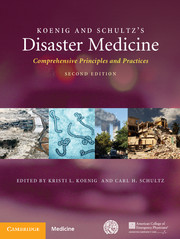Book contents
Part I - Conceptual Framework and Strategic Overview
Published online by Cambridge University Press: 05 April 2016
- Type
- Chapter
- Information
- Koenig and Schultz's Disaster MedicineComprehensive Principles and Practices, pp. 1 - 162Publisher: Cambridge University PressPrint publication year: 2016



